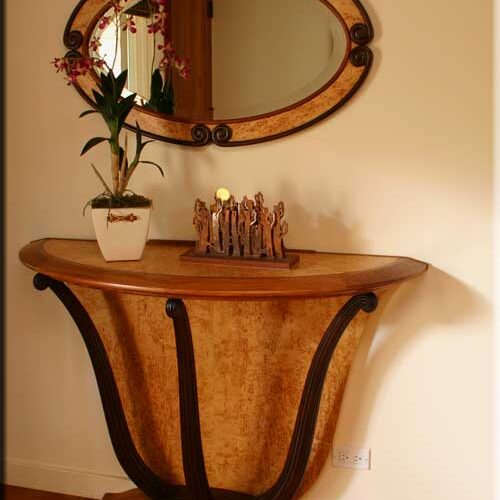By Garet, Barbara – Publication: Wood & Wood Products
Date: Thursday, October 1, 1998
Less is indeed more at Design Emphasis ’98 where the best of 170 projects became Award Winners.
“FULL OF SHINING PROMISE”
The words hung in the air as one by one the students or their representatives walked to the podium to accept the awards, perhaps the most significant honor of their young lives. The reference was to the finalists of Design Emphasis ’98, a student furniture design contest sponsored by the International Woodworking Fair.
The speaker was Ingrid Volk, IWF ’98 chairperson and vice president of European Woodworking Machinery, who presided at the awards ceremony at the Georgia World Congress Center, Atlanta, on Aug. 20.
Volk’s comments underlined the fact that Design Emphasis attracts, encourages, recognizes, and honors students from the premier woodworking schools and furniture design programs in the United States. A total of 19 schools were represented by the 58 finalists. Eleven schools accounted for the 16 award winners.
Joe Richardson III, Design Emphasis ’98 chairman and president of Richardson Bros., presented awards for Winner, $1,250; Merit, $500; and Honorable Mention, $250, in each of five categories: Seating, Ready-to-Assemble, Contract, Case Goods and Design Creativity. The overall Best-of-Show Award was $2,000.
A panel of 10 judges chose the award winners by a point system based upon design creativity, adaptability to production processes, marketability, and workmanship. Entries had to be at least 50 percent solid wood or wood composite; upholstery entries required frames of solid wood or wood composite materials.
Judges included Richardson; Albert Pfeiffer, curator of the Knoll Museum; Arto Szabo and Thomas Keller, furniture designers; Rosanne Somerson, head of the Department of Furniture Design, Rhode Island School of Design; and Brian Alexander, creative director of Haworth Inc.
Other judges were Max Shangle, Furniture Design coordinator of Kendall College of Art and Design; Carla Greenblatt of Haverty’s; and Lester Craft, editorial director of Furniture Today, and myself.
Marilyn Jeans of IWF coordinated the biennial competition, which began in 1970 in Louisville, KY, where entries were judged from models. Jeans said about 170 entries were received this year. Selection of the finalists was completed in May.
And the winners were…
Meng-Fang Wu of Kendall College captured Best of Show for a maple credenza with squares and parallel lines that harkened back to Arts and Crafts influences. In addition, Wu received Honorable Mention in Seating for his natural-finish maple chair with circular red arms.
In the Design Creativity category, Robert Stefaniw of Rockingham Community College was named Winner for his altar-shaped Bonsai Table with hammered copper basin and pegged legs; Greta Gonzalez, Auburn University, Merit Award, for Valet; and David Van Deman, Purdue, Honorable Mention for Kangaroo Chair.
Design Emphasis award winners for Case Goods were: Venus Yuen Yee Chan, Art Center College of Design, for Nutcracker Activity Center; Leanne Vesecky, Pittsburg State University, Jewelry Armoire; and Jeff Reeder, Pittsburg State University, Entertainment Center. Robert Lippoth, Rochester Institute of Technology, was the Seating Winner for Arched Back Chair. Tyler Gardner, Haywood Community College, received Seating Merit Award for “Just Clowning Around.”
Ready-to-Assemble prize winners were a coffee table by Mark Krasne, University of Kansas; adaptable office table by Julien Egger, Art Center College of Design; and computer desk, Donwoong Kang, Columbus College of Art and Design.
Contract awards were given for a curved glass office table, Tom d’Agostino, Auburn University; Bach Violin Table, Bayer Johannes, Art Center College of Design; and bent ash table, Chuck Heydinger, University of Kentucky.
They came to conquer. These students came to Atlanta to declare that creativity can come to terms with the marketplace. Yee Chan’s colorful, functional, and space-saving Nutcracker Activity Center is one example. Scaled appropriately for children, it is fun to look at and to explore. A friendly face tops a case with hinged front that drops down to become a work surface. Bookshelves line the sides. Flat surfaces and straight lines make this little guy a natural for mass production.
The 1998 student-designers also indicated, by means of beautifully made furniture, their optimism that fine workmanship need not give way to production demands. The judges, delighted with the construction, awarded many pieces the highest possible points for workmanship. Vesecky’s Post-Modern armoire and Wu’s detailed maple credenza, among others, were noted for high-caliber woodworking.
These are mature students who clearly respect their design forbears. Gonzalez’s Valet earned points for its Minimalist, bare-bones, “less is more” approach, while still maintaining the requisite 50 percent wood composition. Van Deman followed Bauhaus rules for his Kangaroo Chair, allowing form to follow function faithfully.
The principles of Experimentalism prevailed in problem-solving projects, for example, designing a perch for a performing artist (Chair for a Guitarist), or answering the question: “How would you incorporate an auto part in a piece of furniture?” – (Car Transmission Chest). Even Pop Art popped up in a just-for-fun Funky Chair with Elephant Feet and the Clowning Around Chair sized for adults.
The talent that came to Atlanta is obvious—and praiseworthy. In general, however, this year’s designs were more conservative than one would expect from students who aspire to blaze trails in the new millennium.
We wish there had been more daring concepts like Kang’s RTA desk, and innovative use of materials similar to Johannes’s table. We looked for inventions to open minds and alter standard perceptions of furniture function. In short, we wanted to discover furniture conspicuously geared for the year 2001.
